 TDRS-G before launch at Kennedy Space Center | |
| Mission type | Communication |
|---|---|
| Operator | NASA |
| COSPAR ID | 1995-035B |
| SATCAT no. | 23613 |
| Mission duration | Planned: 10 years Elapsed: 29 years and 14 days |
| Spacecraft properties | |
| Bus | TDRS |
| Manufacturer | TRW |
| Launch mass | 2,108 kilograms (4,647 lb) [1] |
| Dimensions | 17.3 metres (57 ft) long 14.2 metres (47 ft) wide |
| Power | 1700 watts |
| Start of mission | |
| Launch date | 13 July 1995, 13:41:55 UTC |
| Rocket | Space Shuttle Discovery STS-70 / IUS |
| Launch site | Kennedy Space Center, LC-39B |
| Contractor | Rockwell International |
| Orbital parameters | |
| Reference system | Geocentric orbit |
| Regime | Geostationary orbit |
| Longitude | 150.0° West (1995–1996) 171.0° West (1996–2003) 150.5° West (2003–) |
| Epoch | 14 July 1995 [2] |
TDRS-7, known before launch as TDRS-G, is an American communications satellite, of first generation, which is operated by NASA as part of the Tracking and Data Relay Satellite System. It was constructed by TRW as a replacement for TDRS-B, which had been lost in the Challenger accident, and was the last first generation TDRS satellite to be launched.
History
[edit]TDRS-7 is based on a custom satellite bus which was used for all seven first generation TDRS satellites.[3] Whilst similar to its predecessors, it differed from them slightly in that twelve G/H band (C band (IEEE)) transponders which had been included on the previous satellites were omitted.[4] It was the last communications satellite, other than amateur radio spacecraft, to be deployed by a Space Shuttle.
Launch
[edit]
The TDRS-G satellite was deployed from Space Shuttle Discovery during the STS-70 mission in 1995. Discovery was launched from Kennedy Space Center Launch Complex 39B at 13:41:55 UTC on 13 July 1995.[5] TDRS-G was deployed from Discovery around six hours after launch, and was raised to geosynchronous orbit by means of an Inertial Upper Stage.[5]
Deployment
[edit]The twin-stage solid-propellent Inertial Upper Stage made two burns. The first stage burn occurred around an hour after deployment from Discovery, and placed the satellite into a geosynchronous transfer orbit. At 02:30 UTC on 14 July 1995 it reached apogee, and the second stage fired, placing TDRS-G into geostationary orbit.[6] At this point, it received its operational designation, TDRS-7. It was placed at a longitude 150.0° West of the Greenwich Meridian, where it underwent on-orbit testing. In May 1996, it was moved to 171.0° West where it was stored as an in-orbit spare, and subsequently entered service.[7] In December 2003, it was relocated to 150.5° West.[8] It arrived the next month, and was returned to storage as a reserve satellite.


See also
[edit]References
[edit]- ^ "UCS Satellite Database". Union of Concerned Scientists. 1 July 2009. Retrieved 9 August 2009.
- ^ "NASA – NSSDCA – Spacecraft – Trajectory Details". nssdc.gsfc.nasa.gov. Retrieved 2 May 2018.
 This article incorporates text from this source, which is in the public domain.
This article incorporates text from this source, which is in the public domain.
- ^ Krebs, Gunter. "TDRS 1, 2, 3, 4, 5, 6". Gunter's Space Page. Retrieved 9 August 2009.
- ^ Krebs, Gunter. "TDRS 7". Gunter's Space Page. Retrieved 9 August 2009.
- ^ a b McDowell, Jonathan. "Launch Log". Jonathan's Space Page. Retrieved 9 August 2009.
- ^ McDowell, Jonathan. "Index". Geostationary Orbit Catalog. Jonathan's Space Page. Archived from the original on 6 April 2010. Retrieved 9 August 2009.
- ^ "The TDRS-J satellite". Spaceflight Now. 1 December 2002. Retrieved 9 August 2009.
- ^ "TDRS 7". TSE. Retrieved 9 August 2009.

Well, that’s interesting to know that Psilotum nudum are known as whisk ferns. Psilotum nudum is the commoner species of the two. While the P. flaccidum is a rare species and is found in the tropical islands. Both the species are usually epiphytic in habit and grow upon tree ferns. These species may also be terrestrial and grow in humus or in the crevices of the rocks.
View the detailed Guide of Psilotum nudum: Detailed Study Of Psilotum Nudum (Whisk Fern), Classification, Anatomy, Reproduction